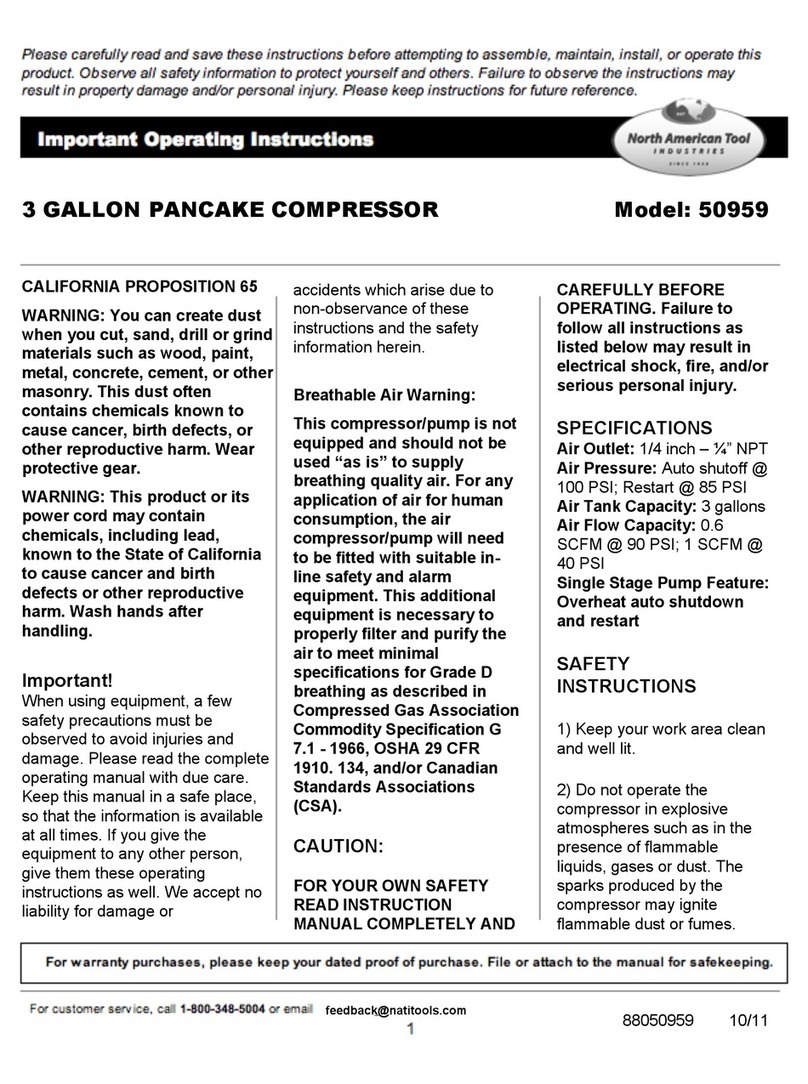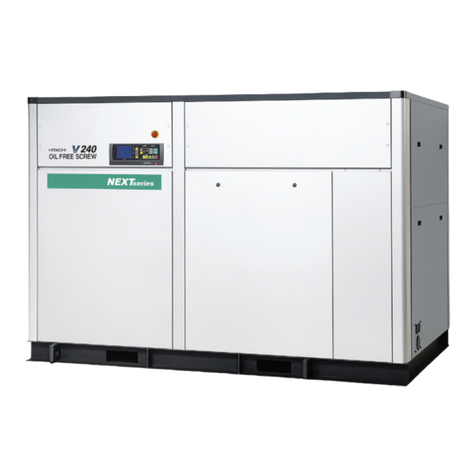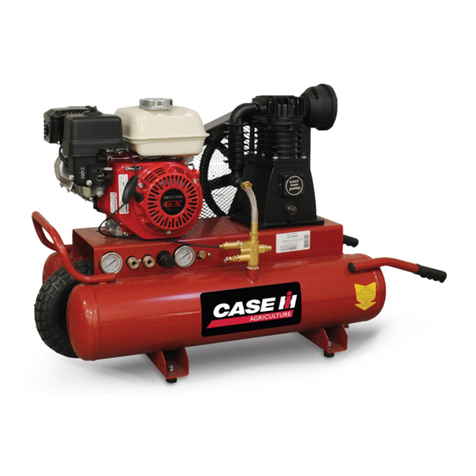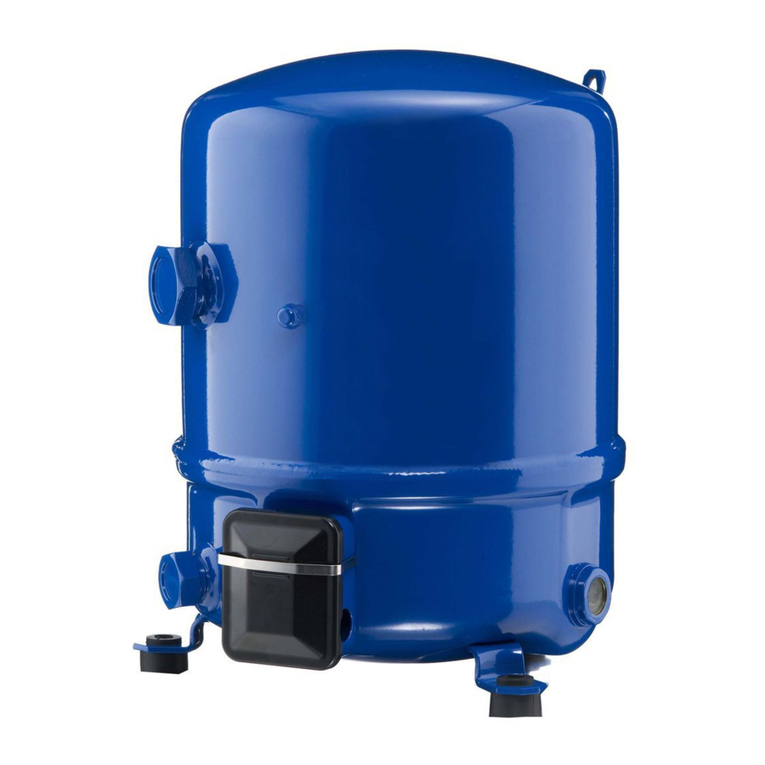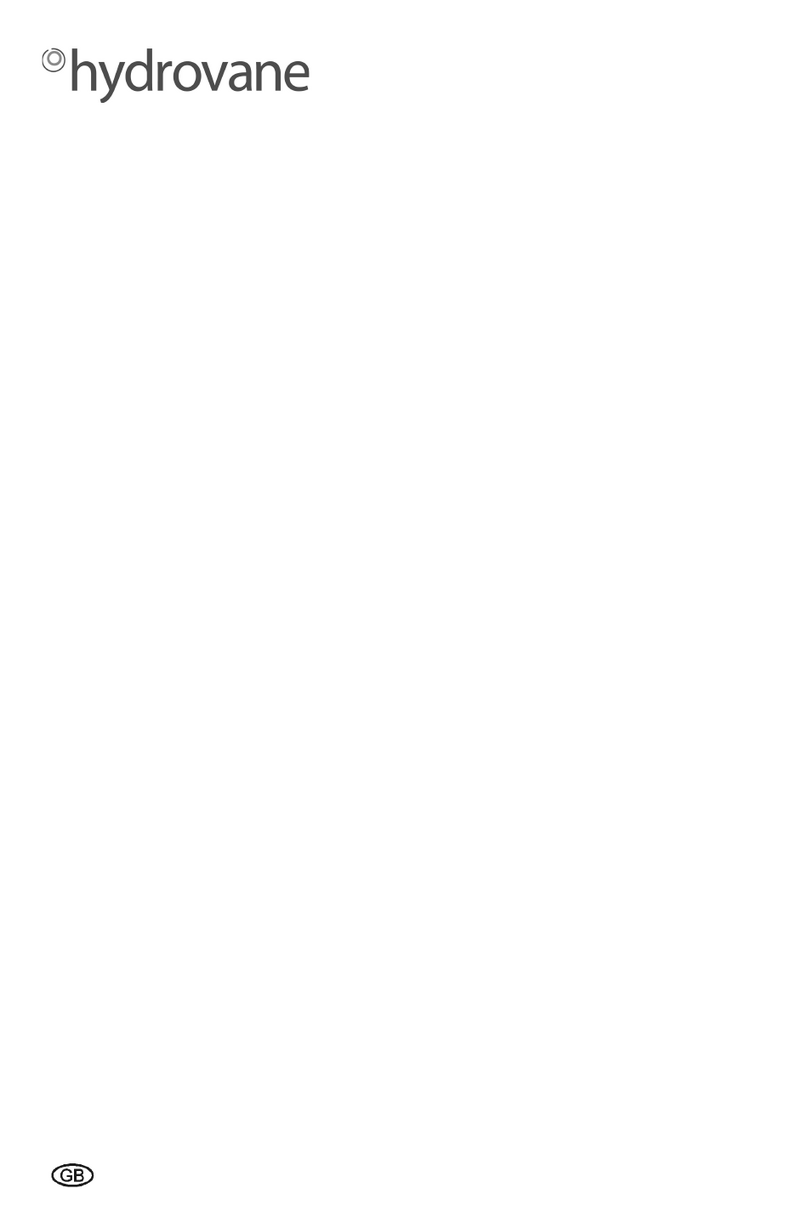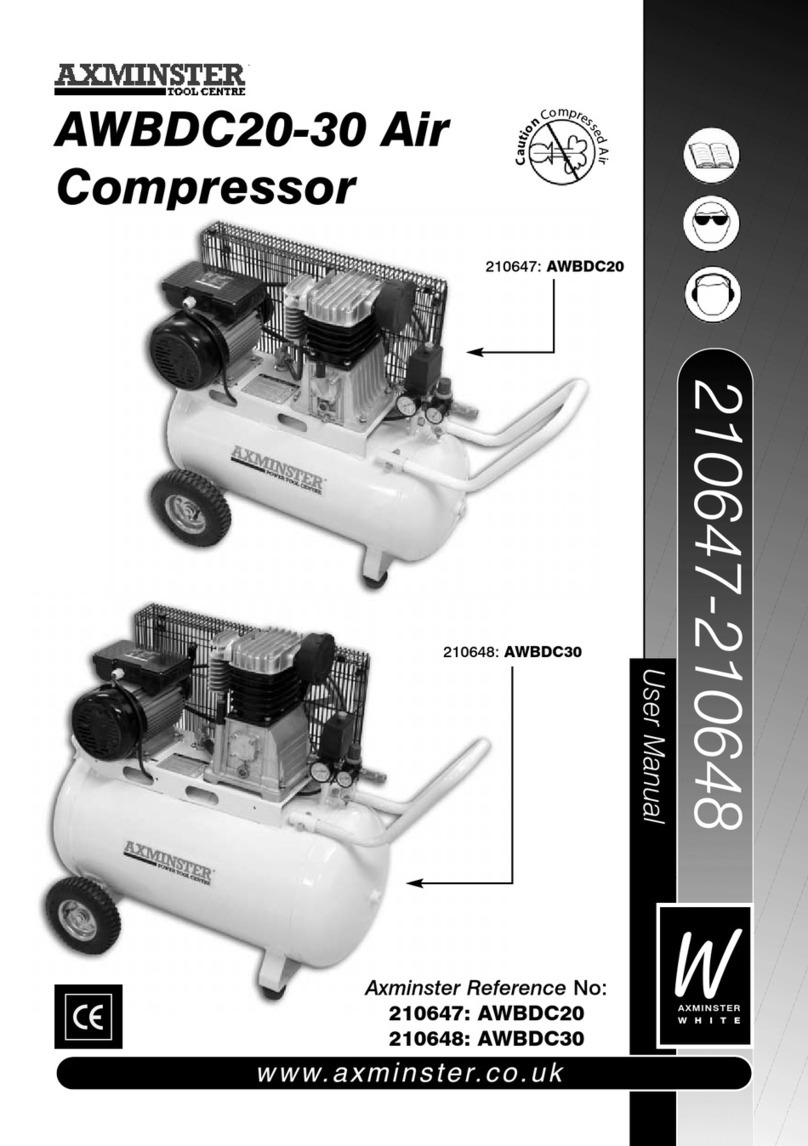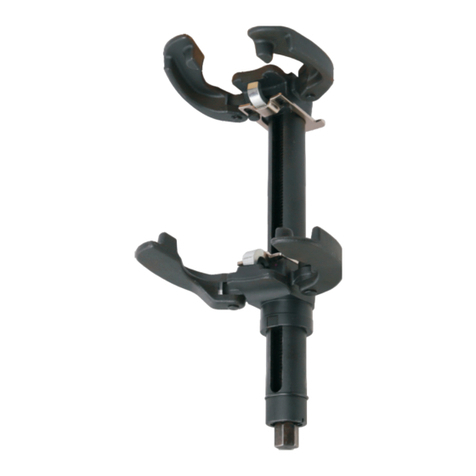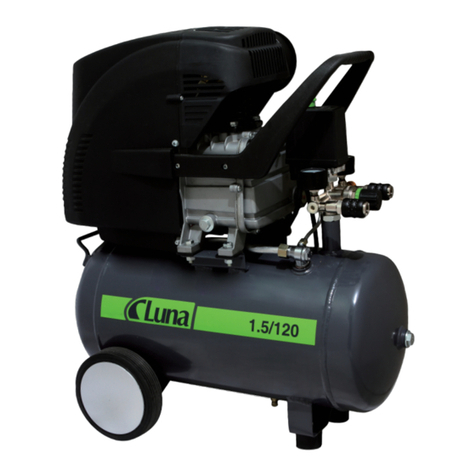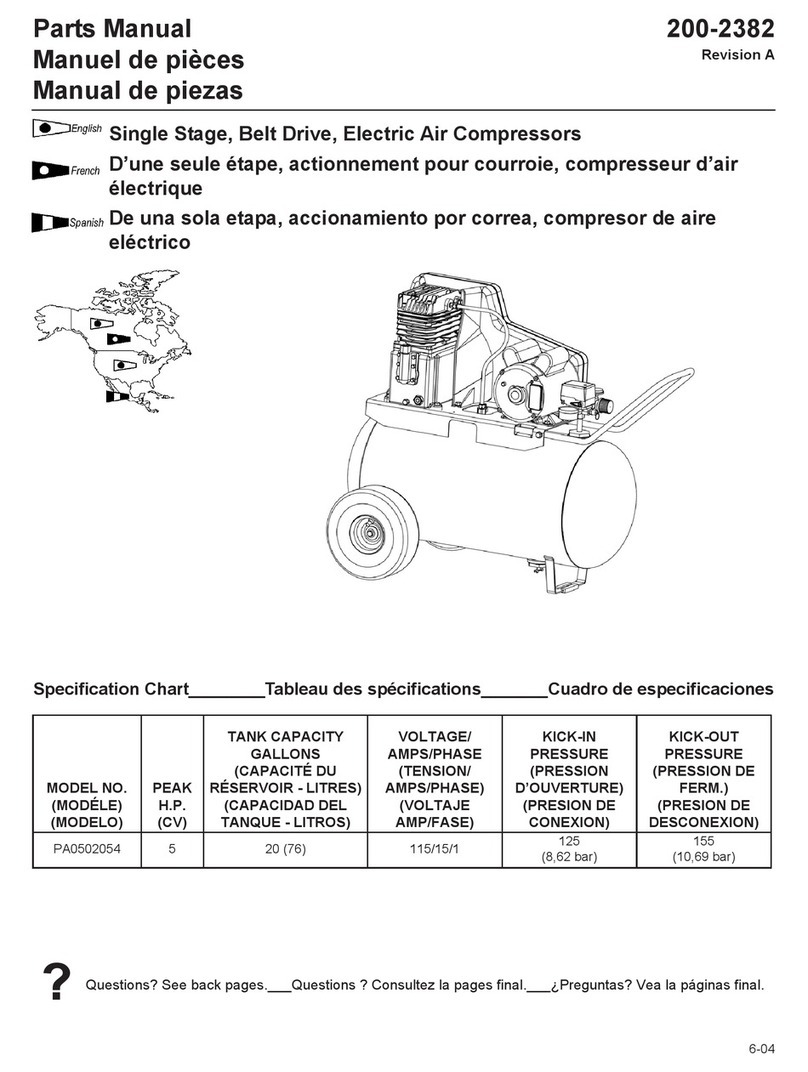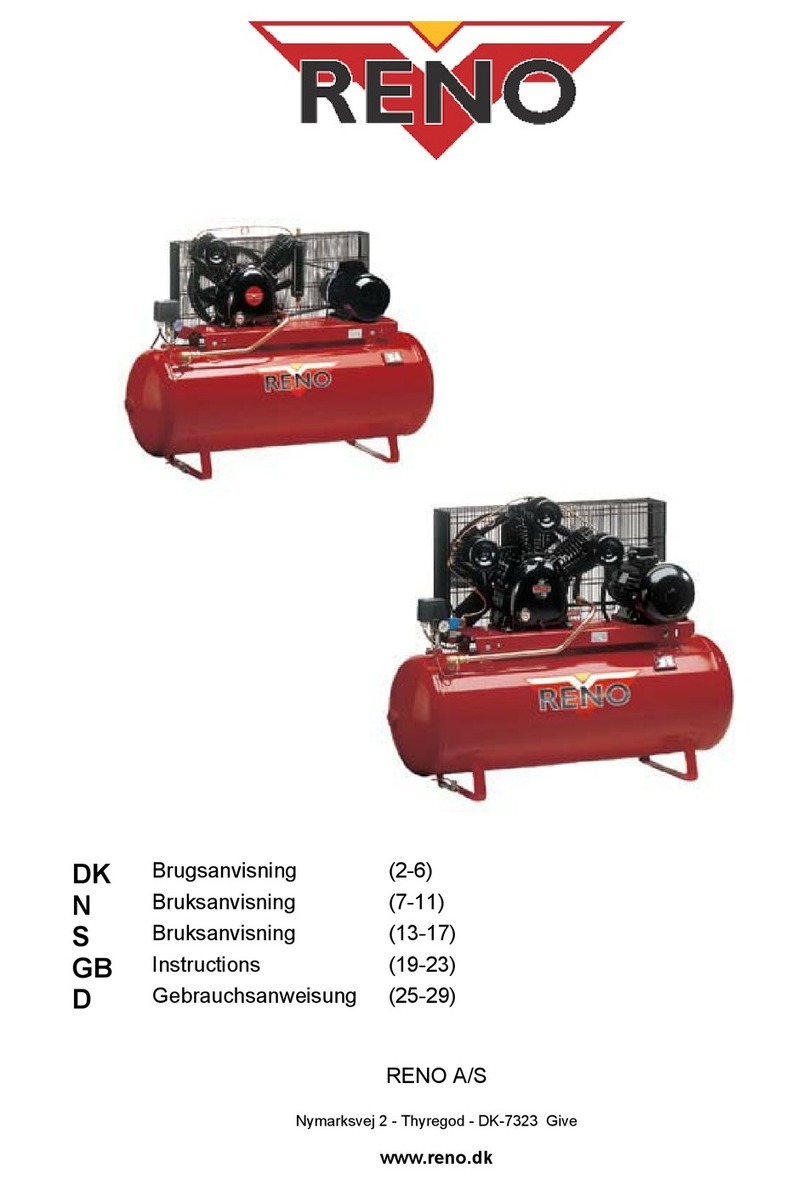North American Tool Industries 51866 Operating instructions

88051870 08/11
5HP 80 GALLON TWO
STAGE COMPRESSOR
CALIFORNIA PROPOSITION 65
WARNING: You can create dust
when you cut, sand, drill or grind
materials such as wood, paint,
metal, concrete, cement, or other
masonry. This dust often
contains chemicals known to
cause cancer, birth defects, or
other reproductive harm. Wear
protective gear.
WARNING: This product or its
power cord may contain
chemicals, including lead,
known to the State of California
to cause cancer and birth
defects or other reproductive
harm. Wash hands after
handling.
CAUTION:
FOR YOUR OWN SAFETY READ
INSTRUCTION MANUAL
COMPLETELY AND CAREFULLY
BEFORE OPERATING THIS
COMPRESSOR.
Failure to follow all instructions
as listed below may result in
electrical shock, fire, and/or
serious personal injury.
BREATHABLE AIR
WARNING:
This compressor/pump is not
equipped and should not be
used “as is”to supply
breathing quality air. For any
application of air for human
consumption, the air
compressor/pump will need
to be fitted with suitable in-
line safety and alarm
equipment. This additional
equipment is necessary to
properly filter and purify the
air to meet minimal
specifications for Grade D
breathing as described in
Compressed Gas Association
Commodity Specification G
7.1 - 1966, OSHA 29 CFR
1910. 134, and/or Canadian
Standards Associations
(CSA).
SPECIFICATIONS:
Tank Size: 80 gallons
PUMP RPMs: 1050
CFM: 13.0 @ 40PSI; 12.0 @ 90
PSI
Max Pressure: 150 PSI
Thermal overload protection
SAFETY WARNINGS
Disconnect power and
release all pressure from
the system before
attempting to install,
relocate, service or perform
any maintenance on this
compressor.
Never store flammable
liquids or gases near the
compressor. Electric arcs
can be produced by the
electric motor and pressure
switch.
Do not operate the
compressor without the
belt guard in place. Moving
parts can cause serious
injuries.
1) Follow all electrical and
safety codes along with
National Electrical Codes
(NEC) and Occupational
Safety and Health Act
(OSHA).
2) Electric motors and
starters must be securely and
properly grounded.
Models: 51866, 51870
feedback@natitools.com

2
3) Do not allow the cable to
come into contact with oil,
grease, chemicals or sharp
objects. Do not allow kinks to
form in the cable.
4) Do not exceed the pressure
limits for any component in or
connected to the system.
5) Inspect the compressor to
make sure that all the fittings,
bolts, etc., are tight and secure
before starting the compressor.
6) Do not touch the compressor
or motor while it is in operation.
These parts become HOT
during normal operation. Allow
the unit to cool completely
before performing maintenance
or repairs.
7) Do not increase the settings
on control components. These
settings provide safety against
over pressurization. The
pressure switch settings are
preset at the factory for normal
operating conditions and
increasing the settings will
result in compressor and motor
damage.
8) Regularly inspect the hoses,
plugs, fittings, piping, wires,
etc., for signs of damage,
weakness or leakage before
starting and using the
compressor.
9) Fast moving air can stir up
dust and debris, which may be
harmful. Release the air slowly
when draining moisture
or depressurizing the unit.
10) Tanks rust and weaken with
moisture. Ensure the tank is
drained daily to avoid rust
formation.
11) Inspect the air tank for rust,
pin holes, cracks (especially in
rear welds), bulges and other
changes in the tank.
12) Never weld or drill holes in
the air tank.
13) Keep others at a safe
distance from the work area.
SPRAYING
PRECAUTIONS
1) Always wear a respirator and
safety glasses when spraying.
2) Always spray in an open, well-
ventilated area to prevent fumes
from accumulating and causing
fire and health hazards. Fumes
are dangerous.
3) Do not spray materials near
open flames and electrical
equipment.
4) Do not smoke while spraying
insecticides, paint or other
flammable substances.
5) Do not direct paint or other
sprayed material at the
compressor. Make sure the
compressor is as far away from
the spraying area as possible to
minimize overspray accumulation
on the compressor.
6) When spraying solvents or
chemicals, follow the
instructions that are provided
by the manufacturer.
7) Never use air pressurized
accessories or parts in the air
system that are not suitable for
150 PSI.
When high humidity is present
or when a compressor is used
for an extended period of time,
moisture will collect in the tank.
This condensation can cause
water droplets to appear in
paint that is sprayed. To
eliminate this moisture, drain
the tank often to reduce the
buildup. A filter in the air line
can help eliminate this
moisture when it is located as
near to the gun as possible.
INSTALLATION
Location
It is extremely important to
install the compressor in a
clean, well-ventilated area.
Make sure the temperature will
not exceed 100 degrees
Fahrenheit. A minimum
clearance of 12 to 18 inches
between the compressor fly
wheel or fan and walls is
required because objects could
obstruct the air flow.
Do not locate the
compressor air inlet near
steam, paint spray,
sandblast areas or any other
source of contamination.
feedback@natitools.com

3
Tank Mounting
The tank should be bolted on a
concrete floor or on a separate
concrete foundation. Vibration
isolators can be used between
the tank leg and the floor. When
using isolator pads, do not draw
bolts tight. Allow the pads to
absorb vibrations. When
isolators are used, a flexible
coupling should be installed
between the tank and service
piping.
Vertical tanks have three feet
and do not need shimming as
long as the floor or foundation is
level.
Never use wood shipping
skids for mounting the
compressor!
Installing A Shut Off Valve
A shut off valve should be
installed on the discharge port
of the tank to control the air flow
out of the tank. The valve
should e located between the
tank and the piping system.
Do not install a shut off valve
between the compressor
pump and the tank. Personal
injury and/or equipment
damage could occur.
Piping
If a pipe line is used, the line
must be at least ¾inch NPT.
Smaller piping restricts the air
flow. Use 1 inch NPT pipe if the
pipe line is over 100 feet
long in order to prevent
excessive pressure drops.
Bury underground lines below
the frost line and avoid pockets
where condensation can gather
and freeze.
Apply air pressure to the piping
installation and make sure all
joints are free from leaks before
underground lines are covered.
Before using the compressor,
find and repair all leaks in the
piping, connections and fittings.
ELECTRICAL INSTALLATION
All wiring and electrical
connections should be
performed by a qualified
electrician. Installation must
be in accordance with local
and national electrical codes.
Grounding
This unit must be grounded.
Grounding the compressor
reduces the risk of electrical
shock by providing an escape
wire for the electric current if a
short circuit occurs. This product
must be equipped with a power
cord or cable that provides a
grounding wire.
Improperly grounded motors
and starters are shock
hazards. Ensure all equipment
is properly grounded.
Wiring
Have an electrician connect the
feedback@natitools.com
unit to an appropriate line
disconnect service and make
sure that the electric disconnect
and fuse box are large enough
and located within sight distance
of the compressor, the service is
of adequate ampere rating, the
supply line has the same
electrical characteristics (phase,
cycles, voltage) as the motor,
and the line wire is the proper
size and no other equipment is
operated from the same line.
ALWAYS INSURE THE MOTOR
IS ROTATING “Clockwise”when
facing the front of the
compressor.
ASSEMBLY INSTRUCTIONS
Do not operate the compressor
without lubricant or with low
lubricant levels.
1) Check the oil level. Add
additional oil if needed. If using
for the first time, pour 30W non
detergent S.A.E.oil into the pump
crankcase until the oil reaches
the red dot on the oil level sight
glass. Do not over fill.
2) Install oil fill plug before
starting.
3) Close the tank valve on the
bottom of the air tank by turning
the valve clockwise.
4) A shut off valve (ideally ¾”)
should be installed on the
discharge port of the tank. Use
Teflon tape on the threads to
ensure an airtight connection
between the tank and the
plumbing or hose coupler. Do not
over tighten the fittings.
5) Attach the supplied air filter to

4
the air intake port on the pump
head.
6) Attach the air hose and any
desired accessories (not
included). Use Teflon tape on
the threads to ensure an airtight
connection. Do not over tighten
the fittings. Note: Vibration
isolator pads are recommended
prior to bolting to the floor. Only
mount the compressor to a
concrete floor or concrete pad.
OPERATING
INSTRUCTIONS
Start Up
1) Turn the ON/OFF switch to
the off position.
2) Check the air compressor
visually for any damage or
obstruction.
3) Close the drain valve.
4) Turn the ON/OFF switch to
the ON position and the
compressor should start and
build air pressure in the tank to
cut-out pressure and then shut
off automatically.
5) It is recommended that an
inline regulator or FRL is
installed before using this air
compressor. A regulator will
insure the proper recommended
operating pressure (PSI) setting
is used for the air tool or air
accessory being used.
7) The air compressor is ready
for use
.Once started, the compressor
will start and stop
automatically until the power
is disconnected.
ASME Safety Valve
DO NOT REMOVE OR TAMPER
WITH THIS VALVE. This valve
automatically releases air if the
tank pressure exceeds the preset
maximum for this unit (150 PSI).
This valve should be checked
occasionally by pulling the ring
by hand. If air leaks after the ring
has been released, or the valve
cannot be actuated by the ring
and is stuck, the valve MUST be
replaced.
Shut Down
1) Turn the ON/OFF switch to the
OFF position.
2) Unplug the power cord from
the receptacle.
3) Set the outlet pressure to zero
on the regulator.
4) Remove any air tools or
accessories.
5) Open the drain valve allowing
air to bleed from the tank. After
all of the air has bled from the
tank, close the drain valve to
prevent debris buildup in the
valve.
Water that remains in the tank
during storage will corrode and
weaken the air tank which could
cause the tank to rupture. To
avoid serous injury, ensure the
feedback@natitools.com
tank is drained properly after
each use or daily.
Check the tank safety valve and
air filter before each use.
MAINTENANCE
Before starting maintenance,
ensure the air compressor is
turned off, disconnected from the
power source, the tank is drained
and the compressor is cooled
down completely.
Never repair a cracked tank or
personal injury could occur.
Daily:
- Check oil level
- Drain accumulated liquid from
tank
- Check for oil leaks
- Check for unusual noise and/or
vibrations
- Check all fasteners are secure
Weekly:
- Check safety relief valve. DO
NOT DISSASEMBLE THE
VALVE WITH AIR IN TANK.
- Inspect and clean air filter
- Clean breather holes on oil
check dipstick
Monthly:
- Check for air leaks by applying
a solution of soapy water around
joints. Look for air bubbles
around joints when the
compressor reaches the
pressure cut-out limit and pump
turns off.
- Check all nuts and bolts are
tight

5
Six months or 250 operating
hours:
- Change compressor oil (SAE
20 or 30)
Replace oil more frequently
when used in dusty operating
environments.
CHANGING THE OIL
1) Place oil drain pan below the
oil drain plug.
2) Remove oil cap to allow the
air to enter the crankcase.
3) Remove oil drain plug.
4) Allow oil to drain completely.
5) Clean and replace oil drain
plug.
6) Refill crankcase with SAE 20
or SAE 30 weight non-detergent
oil to the red dot on the oil level
sight glass. Be careful not to
overfill the tank.
Do not use multi-grade, ATF,
hydraulic fluid, two-cycle oil or
any other improper oils because
it will void the warranty. Using
automotive engine oils may
cause carbon deposits on
valves and can shorten valve
life.
Changing Filter
Never run the compressor
without an intake air filter or with
a clogged intake air filter. Use
compressed air to blow the filter
clean. If the filter
cannot be blown clean, the filter
should be replaced.
Do not allow intercooler fins to
become clogged with dirt, lint,
dust, paint, etc. If surrounding
air is dirty and is causing the
intercooler to clog, move the
compressor to a cleaner area
or use duct work to bring
clean air into the cooling fan
intake.
feedback@natitools.com

6
feedback@natitools.com
Symptom Possible Cause(s) Possible Solutions
Fuse blown or circuit breaker
tripped
Check for cause of blown
fuse/breaker and replace
Loose electrical connections Check wiring connections
Overheated motor
Turn compressor off, wait until total cool
down. Check to insure the motor is
rotating "clockwise" when facing the
front of the compressor before
restarting
Air leak in safety valve
Check valve manually by pulling
upwards on ring. If condition
persists, replace valve
Defective check valve Replace check valve
Safety valve releasing
Defective pressure switch or
improper adjustment
Check for proper adjustment and if
problem persists, replace pressure
switch
Loose drain valve Tighten drain value
Loose connections at regulator or
pressure switch
Check connections for leaks, seal
with teflon tape
Excessive water in tank Drain tank through drain valve
Humidity too high
Move compressor to an area of less
humidity.
Improper oil viscosity
Replace oil with SAE 20-30 weight
non-detergent oil
Too much oil in crankcase
Drain crankcase and fill to proper
level
Compressor overheated Air pressure regulated too high
Restricted air filter Clean or replace filter
Worn piston rings Replace piston rings
Oil discharge in air
No start condition
Low pressure
Tank pressure drops
when compressor is shut
off
Excessive moisture
coming out of air hose

7
feedback@natitools.com
North American Tool Industries (NATI) makes every effort to ensure that this product meets high quality
and durability standards. NATI warrants to the original retail consumer a 1-year limited warranty from
the date the product was purchased at retail and each product is free from defects in materials.
Warranty does not apply to defects due directly or indirectly to misuse, abuse, negligence or accidents,
repairs or alterations, or a lack of maintenance. This product is intended for personal use. The warranty
will be voided if used in commercial, rental, or industrial applications. NATI shall in no event be liable for
death, injuries to persons or property, or for incidental, special or consequential damages arising from
the use of our products. To receive service under warranty, the original manufacturer part must be
returned for examination by an authorized service center. Shipping and handling charges may apply. If
a defect is found, NATI will either repair or replace the product at its discretion.
DO NOT RETURN TO STORE
For Customer Service:
Email feedback@natitools.com or Call 1-800-348-5004

89051870 08/11
5HP 80 GALLON TWO STAGE COMPRESSOR
Models: 51866, 51870
feedback@natitools.com
8
72

2
feedback@natitools.com 9
No. Description Qty No. Description Qty
1 Bolt 4 33 Bolt 4
2 Spring Washer 4 34 Spring Washer 4
3 Cylinder Head 1 35 Cylinder 1
4 Rear Cover Air Filter 1 36 Cylinder Gasket 1
5 Cylinder Head Gasket 1 37 Piston Ring Set 2
6 Valve Plate 2 38 Oil Ring 1
7 Valve Seat 1 39 Spring Washer 2
8 Cylinder Head Gasket 1 40 Piston Pin 1
9 Valve Seat 1 41 Piston 1
10 Cylinder Gasket 1 42 Connecting Rod 1
11 Bolt 4 43 Splasher 1
12 Spring Washer 4 44 Spring Washer 1
13 Cylinder 1 45 Cross Recess Head Screw 1
14 Cylinder Gasket 1 46 Bolt 1
15 Piston Ring Set 2 47 Spring Washer 1
16 Oil Ring 148 Pulley Washer 1
17 Spring Washer 2 49 Pulley 1
18 Piston Pin 1 50 Bolt 4
19 Piston 1 51 Bearing Seat 1
20 Connecting Rod 1 52 Gasket Bearing Seat 1
21 Splasher 1 53 Oil Seal 1
22 Spring Washer 1 54 Bearing 1
23 Cross Recess Head Screw 1 55 Crankshaft 1
24 Bolt 4 56 Oil Filling Plug 1
25 Spring Washer 4 57 Oil Breather 1
26 Exhaust Elbow 1 58 Motor Bolt 4
27 Cylinder Head 1 59 Washer 4
28 Cylinder Head Gasket 1 60 Six Angle Nut 1
29 Valve Seat 1 61 Crankcase 1
30 Cylinder Head Gasket 1 62 Bearing 1
31 Valve Seat 1 63 Oil Leveler Washer 1
32 Cylinder Head Gasket 1 64 Oil Leveler 1

2
feedback@natitools.com 10
No. Description Qty
65 Oil Drain Plug 1
66 Motor 1
67 Woodruff Key 1
68 Motor Pulley 1
69 V-Belt 2
70 Electric Cable 1
72 Valve Plate 2
74 Air Tank 1
79 Drain Valve 1
81 Check Valve 1
82 Unload Elbow 1
83 Unload Pipe 1
84 Unload Nut 1
85 Pressure Gauge 1
86 Safety Valve 1
87 Nipple 1
88 Pressure Switch 1
89 Quick Connector 1
90 Belt Guard 1
91 Spring Washer 1
92 Bolt 1
93
Exhaust Pipe Assembly
1
94 Exhaust Tube Pipe 1
95 Exhaust tube Elbow 1
This manual suits for next models
1
Table of contents
Other North American Tool Industries Air Compressor manuals
Popular Air Compressor manuals by other brands

4tek
4tek ECO Series Operating and maintenance manual
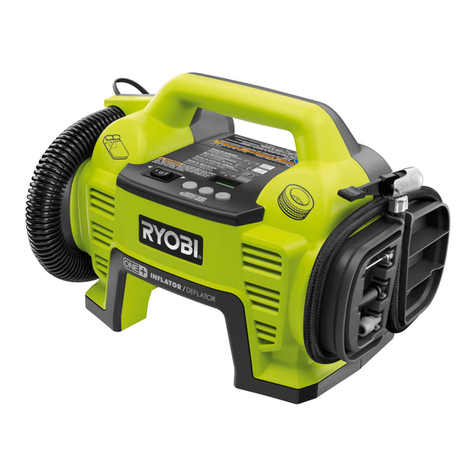
Ryobi
Ryobi R18I-0 Original instructions
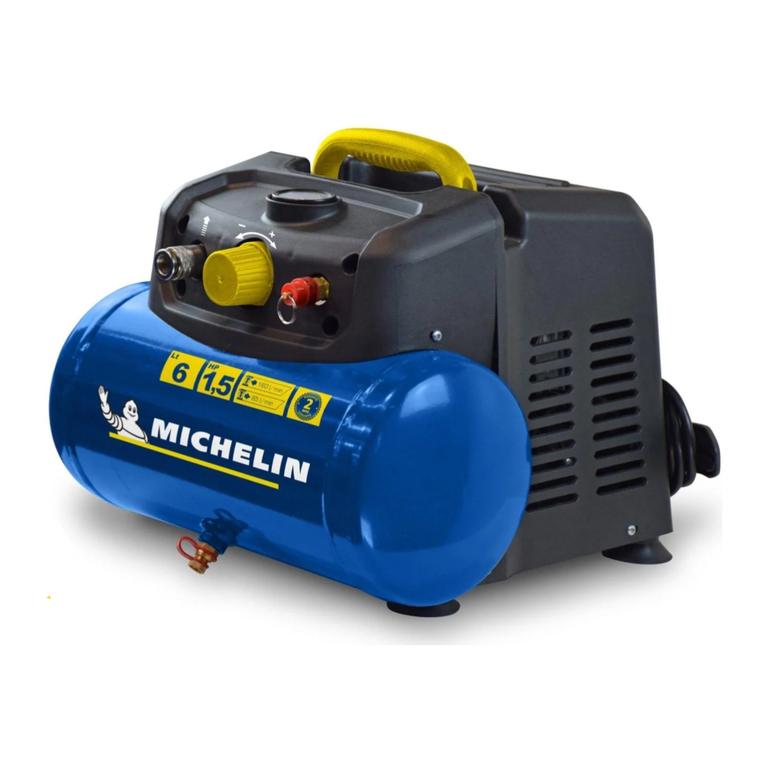
Michelin
Michelin MBL 6V2/1100 user guide
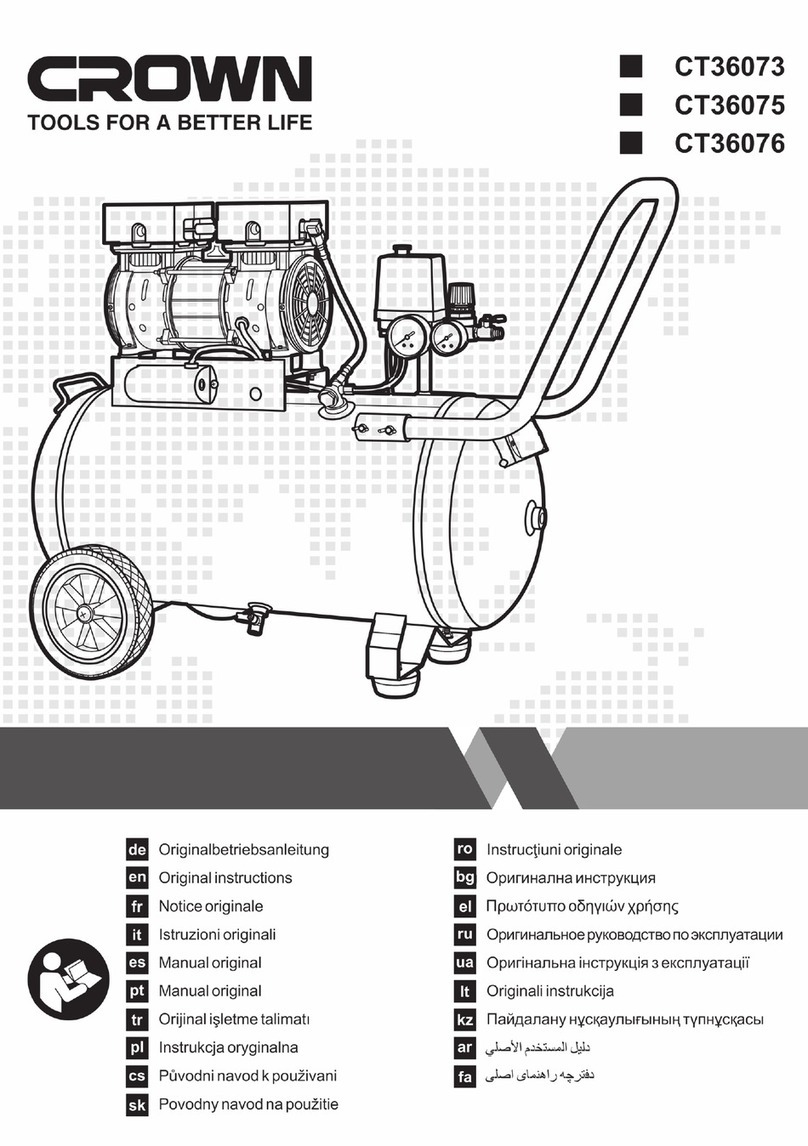
Crown
Crown CT36073 Original instructions
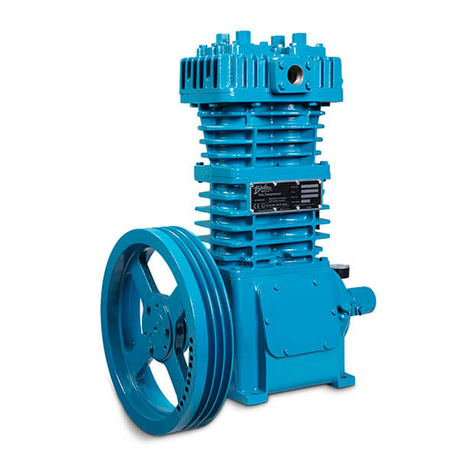
BLACKMER
BLACKMER LB161B Installation, operation & maintenance instructions
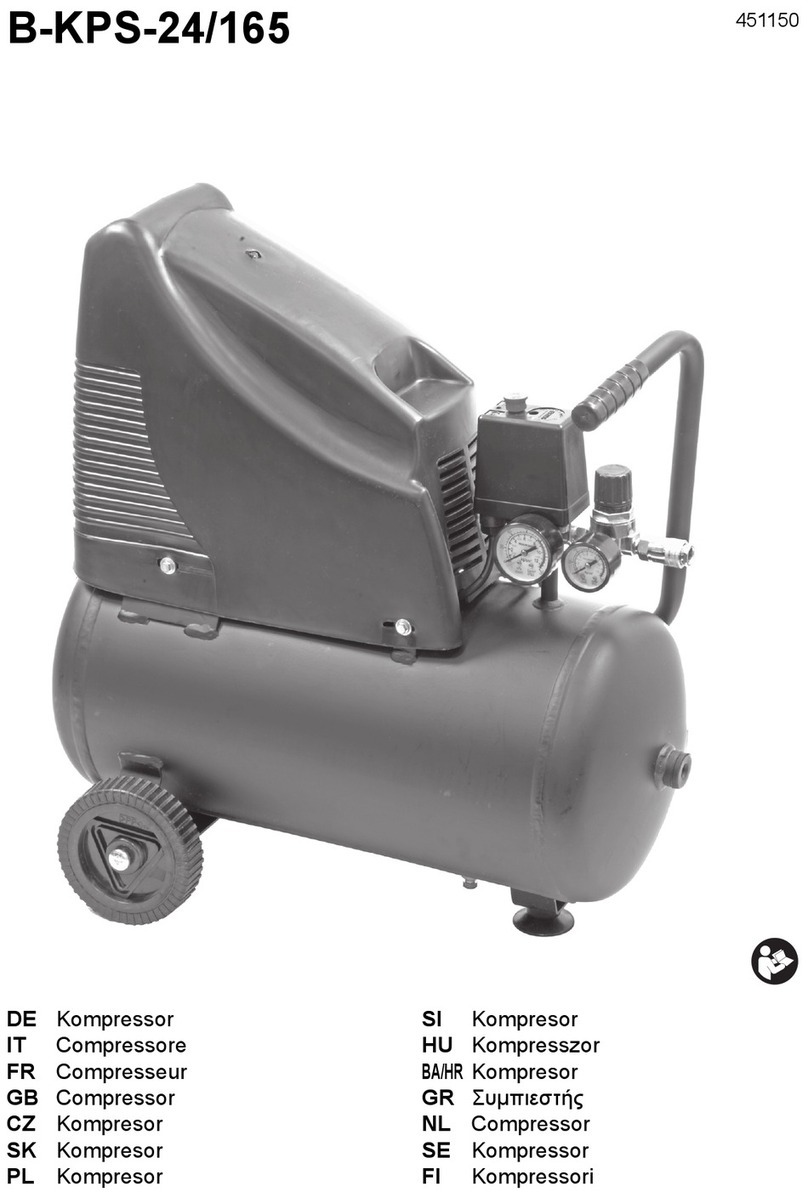
Euromate
Euromate B-KPS-24/165 Translation of the original instructions
